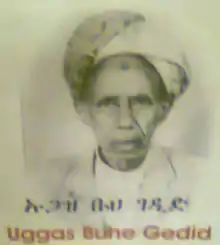Gurgura
The Gurgura, Gorgorah or Gurgure (Somali: Gurgure, Oromo: Gurgura, Arabic: غرغرة) are a transnational clan divided between Somali and Oromo. They were historically Somali and were part of the large Dir clan. They make the majority in the Erer district in the Sitti Zone but also live in Dire Dawa, Harar region, large portions of the Oromia Region (Zone 4) of Ethiopia and the Afar Region of that country.
غرغرة | |
|---|---|
| Regions with significant populations | |
| Languages | |
| Oromo, Somali and Arabic | |
| Religion | |
| Islam (Sunni) | |
| Related ethnic groups | |
| Issa, Gadabursi, Surre, Bursuuk, Biimaal , Garre and other Dir clans. |
Distribution
The Gurgura are of the Madahwein Dir, making them directly related to the Gurre and Gariire and other Madahwein Dirs.[1] [2]
History
The city of Dire Dawa was originally called Dir Dhabe and used to be part of Adal Sultanate during the medieval times and was exclusively settled by Dir clan which is a major Somali tribe and after the weakening of Adal Sultanate, the Oromos took advantage and were able to penetrate through the city and settle into these areas and also assimilate some of the local Gurgura clan.[4]
Oromo political organizations sought to coerce the Gurgura, (who's identity was very contentious for the city of Dire Dawa) who largely speak the Oromo language (Oromiffa), to identify themselves as Oromo, though they belong to the Dir clan family of the Somalis. Oromo political organizations claimed that "the Gurgura people who speak Oromiffa belong to the Oromo nation and they only started to identify themselves with the Somali after the 1974 change of the Haile Selassie regime".[5] This is false since the Gurgura are mentioned in the Futuh Al Habasha : Conquest of Abyssinia as source dating back as far as the 16th century, by author: Shihabudin Ahmad bin Abd al-Qadir 'Arab Faqih or 'Arab Faqih. It is recorded that the Gurgura were Somalis who fought alongside Ahmed Gran or Ahmad ibn Ibrahim al-Ghazi with knights, spear-men and foot-soldiers and their leader Garād 'Abd.[6]
Many prominent Gurgura in Dire Dawa, including traditional leaders, have identified themselves either Oromo or Somali. Since 1991, majority of them identify themselves as Somalis though we have still others that identify themselves as Oromos. [7]
References
- Lewis, I. M. (1998). Peoples of the Horn of Africa: Somali, Afar and Saho. Red Sea Press. ISBN 9781569021057.
At the end of the book "Tribal Distribution of Somali Afar and Saho"
- Expectations and belonging in Dire Dawa Drivers, dynamics and challenges of rural to urban mobility. Research and Evidence facility. 2018. p. 10.
The Gurgura share both Somali and Oromo identities, speaking the Oromo language and tracing their genealogy to the Dir, a Somali clan family.
- Verdier, Isabelle (1997). Ethiopia: the top 100 people. Indigo Publications. p. 13. ISBN 9782905760128.
- ʻArabfaqīh, Shihāb al-Dīn Aḥmad ibn ʻAbd al-Qādir (2003-01-01). The conquest of Abyssinia: 16th century. Annotation: Dir, According to Huntingford a settlement which may be modern Dire Dawa. Tsehai Publishers & Distributors. p. 24. ISBN 9780972317269.
- Sindjoun, Luc (2010). The Coming African Hour: Dialectics of Opportunities and Constraints. African Books Collective. p. 210. ISBN 9780798302302.
- ʻArabfaqīh, Shihāb al-Dīn Aḥmad ibn ʻAbd al-Qādir (2003-01-01). The conquest of Abyssinia: 16th century. Tsehai Publishers & Distributors. pp. 120, 123 and 401. ISBN 9780972317269.
- Asnake Kefale (2014). "Ethnic decentralization and the challenges of inclusive governance in multiethnic cities: The case of Dire Dawa, Ethiopia". Regional & Federal Studies. 24 (5): 589–605. doi:10.1080/13597566.2014.971772. S2CID 154137709.
